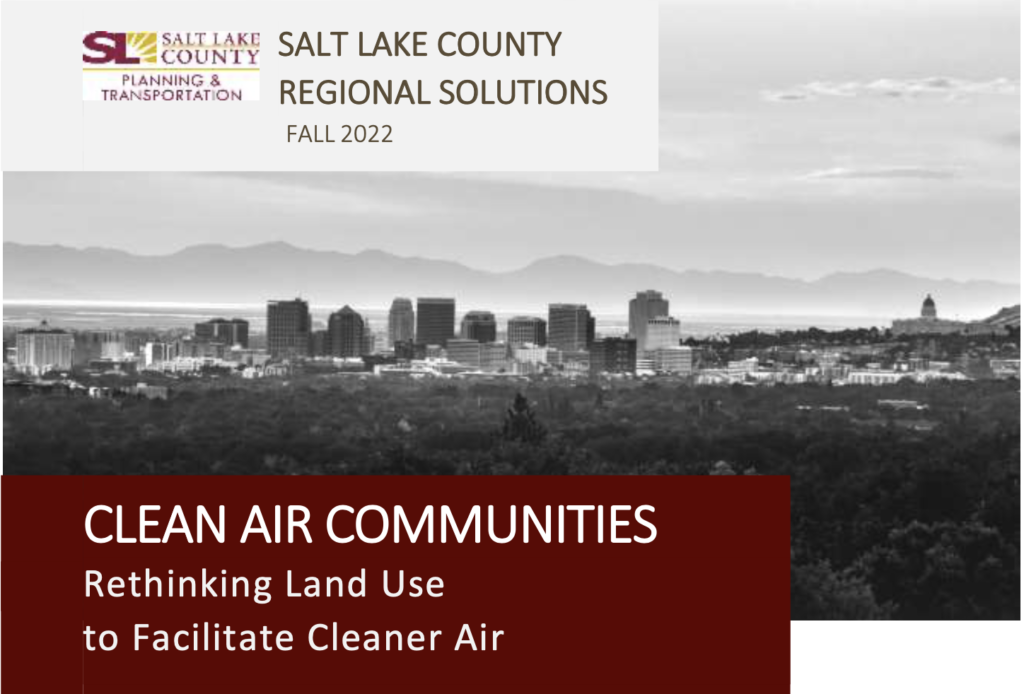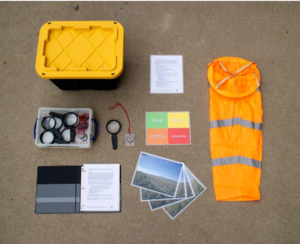Air quality (or poor air quality) impacts human and environmental health around the world. In the Salt Lake Valley, air quality is a constant and growing concern as we experience increased wildfires in the summer resulting in smoke-filled days, and smog-filled inversions lasting weeks during the winter. There are community groups, legislation efforts, and researchers actively working on SLC's air quality, yet there is so much more that could be done.
The Global Changes & Society 2022 students read about air quality and heard from expert researchers and local officials. Students formed interdisciplinary groups in which they explored topics in greater depth, identified needs, and responded to those needs by creating the following projects.
-
Air quality is a major cause for concern for Utahns as it leads to negative health outcomes and reduces overall quality of life, this is especially true for the most vulnerable communities who may have limited or no access to healthcare or resources to cope.
We worked with Salt Lake County to create educational materials (report, interactive mapping, and graphics) to support the continued outreach and discussion among professionals and the public on the topic of air quality within the county. We examine the largest contributors to poor air quality: industrial pollutants, the building stock, land use decisions, and community design locally and nationally. We present existing research that demonstrates the scale of the pollution category and present best practices and policy recommendations based on our findings which include recommendations that have successfully been implemented in other cities. We have combined all resources in a StoryMap which is publicly and easily accessible and has been provided to Salt Lake County where they plan to use our final product and build on it within their team for their Regional Solutions event Fall 2022.

Image: Global Changes & Society 2022 student project - Salt Lake County Regional Solutions: Rethinking Land Use to Facilitate Cleaner Air Link to Clean Air Communities Story Map.
Link to Clear Air Communities Report.
-
Indoor air quality (IAQ) is an increasing concern due to its long-term effects on health. Cities and regions are increasingly exposed to poor air quality due to environmental and anthropogenic factors affecting not only outdoor conditions but also indoors. Although an extensive approach toward improving air quality in areas like Salt Lake City is present, there is no substantial attention to indoor conditions. This includes academia, where little research has been conducted on Indoor Air Quality (IAQ). Nevertheless, people spend more than 80% of their time indoors, where exposure levels can be drastically higher than outdoors. These health effects can reduce local residents’ quality of life.
Watch our presentation about the project here, then read more below.
In this project, we elaborated on general and particular components regarding IAQ and focused on housing conditions. With the support of the Sustainability Office from the Salt Lake City Municipality (SLC Green), we conducted a comprehensive analysis focused on IAQ hazards as a result of several conditions that included construction systems, socioeconomic factors, and behaviors. The project included an analysis of current policies and programs in Utah and several areas of the U.S. to apply lessons in understanding and improving IAQ. We searched and discussed the best adaptable alternatives to the SLC context and their accessibility to different socioeconomic levels.
We created a comprehensive IAQ educational toolkit for household renters and owners that provides a basic understanding of IAQ hazards and alternative solutions.
We developed an in-depth indoor air quality report for the Salt Lake City Sustainability Department. The report Includes background information on indoor air quality, major factors that affect indoor air quality (outdoor sources, housing conditions, human behavior, and socioeconomic factors), air quality policies, and actions/solutions to improve indoor air quality. We included an annotated bibliography of the sources that were included in our report. This will be used to support the Sustainability Department’s educational programming and social media posts about indoor air quality.
This project’s long-term objectives are centered around enhancing knowledge about indoor air quality and, through this, promoting resilience and equity in the long run. Providing a variety of stakeholders – including the city, housing groups, and individual renters and homeowners – with information about indoor air quality helps develop resilience by supplying baseline knowledge necessary to form mitigation and adaptation efforts. Bolstering community resilience is vital and will become increasingly necessary as factors like climate change worsen outdoor air conditions and the city’s housing crisis intensifies in coming years.
This all ties into promoting equity, especially as it relates to the imbalance of tenant-landlord relationships, the city’s housing shortage, renter characteristics, and health disparities. Tenants rely on property owners to maintain the quality and safety of their housing units. In the case of a housing shortage when affordable and available units are difficult to come by, renters have few places to turn if their housing does not adequately protect them from dangers like poor air quality. This issue is compounded by the fact that Utah renters tend to face greater socioeconomic disadvantages compared to homeowners, putting them in a more vulnerable position to face poor health outcomes. Long-term, we hope this project can address these disparities, especially for those who are lower-income or whose health is more at risk.
-
Indoor air quality is strongly connected to health and well being. Breathable air free of health- threatening pollutants can lead to a lower risk of respiratory and other chronic illnesses and a higher quality of life. In homes, there are many common pollutants. These include volatile organic compounds (VOCs), second-hand smoke, radon, nitrogen dioxide, lead particles, asbestos, and mold or mildew. Our project focused on empowering individuals to make small yet impactful changes to improve indoor quality by hosting a tabling event during the University of Utah Earth Week.
We handed out reusable glass spray bottles at the tabling event, each containing a safe, non-toxic, all-purpose cleaning tablet, and provided patrons with an online indoor air quality resource guide. By choosing to take action, individuals can implement more sustainable practices that create a lasting impact on their indoor air quality.
Learn more about this project at the video below:Tackling a significant systemic issue like air pollution can feel daunting and even leave people with a sense of helplessness. This project aimed to empower individuals to make sustainable changes in their lives to promote better indoor air quality for themselves and their loved ones. This project also allowed us to feel like we could influence a small, positive change in others’ lives by getting out into the community and sharing our passion for sustainability and our newfound knowledge of indoor air quality.
Creating sustainable change at the individual level can translate to sustainable change in the whole system. A group of tiny actions individuals take to improve their indoor air quality can ultimately compound together to drive lasting change in Salt Lake City’s air quality system.
-
A Place-Based Educational Toolkit for the Antelope Island State Park Visitor Center
The goal of this toolkit is to help students understand the relationship between air quality and the Great Salt Lake through place-based education methods. We recognized a gap in the existing resources available for toolkits that present air quality in a positive light, and toolkits that specifically connect the issue of air quality with the Great Salt Lake. We partnered with Antelope Island State Park to develop five different activities that strive to foster curiosity and engagement between students and their local environments. Ultimately, we want to encourage them to become stewards of the land, water, air, and the communities to which they belong.
In the video below, we give a quick overview of our project.
Situated upwind of the Salt Lake City Metropolitan Area and at the bottom of a major inversion sink, the Great Salt Lake is a key part of understanding air quality in its bioregion. The Great Salt Lake is also surrounded by 7 of the top 10 point release sites in the most recent Utah Toxic Release Inventory. As the Great Salt Lake shrinks due to outdated water infrastructure, warming climate, and record-breaking population growth, the exposed lakebed also becomes a source of PM2.5 dust which enters the airshed during wind events.
Antelope Island is the largest island on the Great Salt Lake and sees over 1 million visitors per year. Among these are approximately 4,000 students who visit the state park on field trips that engage with established school curriculum through place-based science, technology, engineering, art, and math (STEAM) activities. The existing educational toolkits provided to teachers during these field trips do not contain anything related to air quality, despite its importance and relevance to the Great Salt Lake.
We learned that a global, fear-oriented perspective dissuades people from actively engaging with socio-ecological issues around them like air quality, and decided to turn to a local, solution-oriented perspective. The place-based educational methodology used in this project will prompt youth participants to actively engage with the local landscape and community so that they will be more inclined to participate in local socio-ecological solutions as they grow into civically-engaged adults.
While a handful of local organizations and institutions have created toolkits and curricula surrounding air quality, they are primarily focused on the causes of bad air quality and its harmful effects. In our search for previous work done in this area, we did not find any educational tools that focus on the positives benefits of good air quality, or that engage with air quality directly through place-based learning. This gap, along with the Great Salt Lake’s importance in the air quality conversation, presents a great opportunity to implement a place-based educational toolkit that will engage thousands of students per year and teach them about the importance of good air quality.
We created an educational toolkit for the Antelope Island State Park Visitor Center. The toolkit
 itself and accompanying materials are contained within a bin that will be housed on Antelope Island. Teachers will be able to check out and use the toolkit on their own or with the help of park rangers. The toolkit is designed so that teachers can choose to do all 5 activities, or just a few of them depending on how much time they have. The activities do not build off of each other, but when taught together provide multiple ways of learning and a more comprehensive place-based education. The activities within the toolkit focus on mindfulness observations, art, science, and kinesthetic learning. The activities are designed to help students form a connection to the island and consequently encourage them to become stewards of the island, the lake, and the Great Salt Lake Basin more broadly.
itself and accompanying materials are contained within a bin that will be housed on Antelope Island. Teachers will be able to check out and use the toolkit on their own or with the help of park rangers. The toolkit is designed so that teachers can choose to do all 5 activities, or just a few of them depending on how much time they have. The activities do not build off of each other, but when taught together provide multiple ways of learning and a more comprehensive place-based education. The activities within the toolkit focus on mindfulness observations, art, science, and kinesthetic learning. The activities are designed to help students form a connection to the island and consequently encourage them to become stewards of the island, the lake, and the Great Salt Lake Basin more broadly.Click here for the toolkit document with activities and lesson plans.
<–Back to Global Changes and Society projects, all years.
